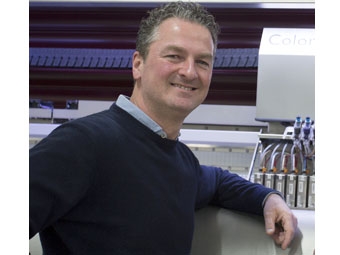In line with its continuing move into expanding market sectors, Hollanders Printing Systems is dividing its portfolio to clarify the specific segments for its digital textile printing solutions. While the company’s single-sided platforms are designed for sign-makers and display producers, there has been noted growth for its double-sided devices which increasingly appeal to specialist products of more industrial applications including printer interior decoration and furnishings.
The reason for this clearer segmentation of its printing systems lies in the changing dynamic world-wide for greater versatility in the textile production sector. While there remains a steady increase in the popularity for single-sided manufacture of soft signs, flags, banners and interior and exterior displays, there has been a distinct change in business model for many industrial fabric specialists that want to take advantage double-sided high-end production to enable localisation through back-shoring and mass customisation via digital technology.
The Hollanders family of single-sided printers comprises its ColorBooster 250 2.5m machine, the wider ColorBooster 320 3.2m, and the ColorBooster XL, a heavy-duty 3.2m machine that bridges the gap between display and industrial production requirements. All are intended to work alongside the ColorFix 320 and the ColorWash 320 for optimum finishing quality.
The double-sided platforms are principally the ColorBooster DS 210 2.1m engine and the 3.2m ColorBooster DS 320, both of which represent the first-ever digital textile systems to output simultaneously on both sides of the fabric. These units incorporate an integrated fixation unit.
All the machines in the Hollanders portfolio are designed to be fully modular and can be upgraded in the field, enabling users to invest according to need and budget and modify when necessary. Options include print-head configuration, plus dust, climate and humidity control and an on-board cleaning system. Every platform offers the ability to be used direct-to-textile or via dye sublimation transfer printing, and feature built-in remote assistance.
This diverse range of machines now available from Hollanders has resulted in a logical division in user type which has resulted in the company now concentrating on the specific needs of the two business models that want to benefit from its wide-format digital textile printers. With its single-sided platform being targeted at the more traditional display segments, the company’s double-sided solution offers the technology and workflow requirements needed by producers of printed interior décor. Both arenas have been boosted in application type by continued improvements to polyesters and mixes that can now successfully emulate the feel and look of natural fibres while still benefiting from the use of disperse high energy and sublimation low energy dyes.
“The display sector is still a growing arena for Hollanders, but shorter lead times and more efficient routes from design to end product has led to an economic and logical desire to produce locally low volumes and samples for industrial textile applications,” explains Jacco Aartsen Tuijn, CEO of Hollanders Printing Systems. “Developers and manufacturers of digital textile printers increasingly need to address the display, the décor and the fashion markets with machines that cater specifically for these segments. This sits in line with our decision to provide greater diversification across emerging substrates, ink advances and product potential.”
All machines in the Hollanders portfolio are designed, developed and manufactured in Eindhoven, The Netherlands with every product tailored to meet the needs of its customers, with emphasis on environmentally friendly practices. The printers, fixation and washing units bring reliability and low cost per square metre within a turn-key system that accommodates a comprehensive and seamless end-to-end workflow, optimised for working with the specific requirements of fabrics.











